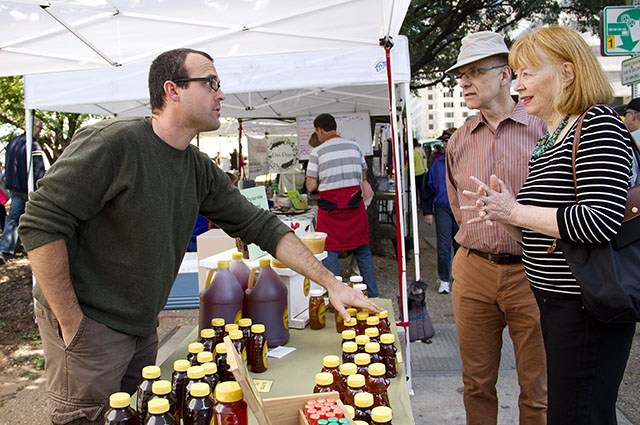In Texas, Add Drought to Beekeepers’ Woes

Mark Bradley talks with Marc Trudeau and Cornelia Brandt at Austin’s Downtown Farmers’ Market about the differences in the types of honey he sells. Photo by Oscar Ricardo Silva.
By Megan Strickland
For Reporting Texas
Beekeepers in Texas are hopeful that a late-blooming wildflower crop will be enough to keep their colonies alive, despite predictions of intensifying drought conditions that have taken a toll on the bee population in recent years.
The local drought is an additional woe that beekeepers in Texas have to deal with on top of a mysterious disorder and parasites that have killed 30 percent of the nation’s bee population in the past few years.
“We are one poor weather event or high winter bee loss away from a pollination disaster,” said national bee researcher Jeffrey Pettis in a report about colony collapse disorder released May 2 by the U.S. Department of Agriculture. The disorder is characterized by unexplained die-offs of adult honeybees in hives. The USDA report said a combination of malnutrition, genetics, pesticides and parasites could be factors of the disorder but did not definitively name a cause. Although Pettis said the disorder has been less prevalent in the past year, it could cause the number of honeybee colonies stewarded by beekeepers in the U.S. to fall to 1.75 million from 2.5 million.
“People should care, because about one-third of our food sources have to be pollinated by insects,” Pettis said in an interview. “Our diet basically depends on it.”
For beekeepers, the collapse disorder joins a list of constant threats, including parasites and weather.
The disorder “is one more stress beekeepers and honey producers don’t need,” Pettis said. “If you had cattle and lost 30 percent of those every year, you’d be screaming.”
Despite the grim national situation, Mark Bradley and his father-in-law, Raul Vergara, began beekeeping in Austin in 2010 after moving from Illinois. Colony collapse disorder hadn’t been a major problem in Texas, Bradley said, so drought posed the greatest challenge to founding the Austin Honey Co., which sells honey produced by hives in East Austin at local farmer’s markets.
“We weren’t used to drought,” Bradley said. “2011 came around and we realized it hadn’t rained since October of 2010, but we thought maybe it will start raining and this is just how it is in Texas.”
Bradley said the drought that year was so bad he had to feed bees in his 23 hives sugar water all year because the nectar and honey they usually feed on weren’t available, other than scant amounts from native prickly pear cactus and mesquite.
“They quickly absorbed all of that, and we lost 13 beehives, most in the winter time because they had been fed sugar water for months and months,” Bradley said. “It was a terrible loss.”
It cost $1,500 to feed the hives that year, and the company did everything it could to keep the hives from growing their populations, Bradley said.
“More bees would have made the cost higher,” Bradley said. “We had to make the decision to continue feeding the bees all year and hope they lived, or stop feeding them because they were likely to die anyway.”
Bradley said rains around Thanksgiving 2011 spurred him to increase his hive count to 50.
“In late March of 2012 we were faced with a decision of OK, let’s double down. It can only get better from here,” Bradley said.
The Austin Honey Co. was able to make its first harvest that year, but left much of the honey that could have been harvested in the hives to feed the bees in case nectar wasn’t readily available. The company hopes to increase its hive count to 120, but it’s hard to make plans with the unpredictable rain patterns, Bradley said.
“It’s difficult to run a honey business with so little rain, but that’s true for the agriculture business overall,” Bradley said. “It looks like the drought returned last October, but we’ve had some rains in April, and we hope that will be a sign of things to come.”
The U.S. Seasonal Drought Outlook prediction issued April 18 by the National Oceanic and Atmospheric Administration isn’t optimistic for drought relief this summer. Drought conditions for the majority of the state are expected to persist, worsen or develop through the end of July. Wildflowers that bloom late in the year require less rain, so the Lady Bird Johnson Wildflower Center, which monitors the state’s wildflowers, said in its April update that the season likely would improve.
Dwain Cleveland owns 40 hives in Somervell County, southeast of Fort Worth, and has been beekeeping for more than two decades. He said the health of the wildflower crop has always been a significant factor for his honey production.
“It’s always been about the wildflowers,” Cleveland said. “We just have to see how many we have.”
In addition to uncertainty about the drought, there’s no time frame for finding a solution to colony collapse disorder, Pettis said. It’s taken more than two decades for scientists studying bees to identify ways to manage a non-native bee parasite, the varroa mite. Despite advancement in pesticides and management, the parasite still kills 10 percent of U.S. bees annually, Pettis said, although the disorder doesn’t get much attention.
“It’s just not as sexy as colony collapse disorder in a story,” Pettis said. “Beekeepers just kind of have to watch the studies and adjust their management practices to whatever comes their way.”